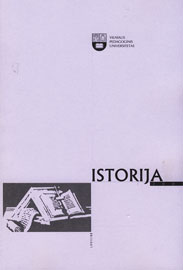„Kijevas Žemaitijoje": Kaunas Vakarų Europos XVII a. leidiniuose
Kaunas Known as „Kiow in Samogitia" in Western European Sources of the 17th Century
Author(s): Rūstis KamuntavičiusSubject(s): History
Published by: Vytauto Didžiojo Universitetas
Keywords: Kaunas; Kiow; Samogitia; Western European; 17th Century
Summary/Abstract: The article reviews the information about Kaunas and other towns of the Grand Duchy of Lithuania in the 17* century on the basis of cosmographic, travellers' memoirs and the information presented by a popular French newspaper „La Gazette". The first part of the article gives information about the most frequently visited and described Lithuania's regions. The second part explains how Kaunas' geographical situation was perceived by foreigners and how differently the city's name was used by them. The majority of travellers who came to Lithuania from Kraków, Warsaw, etc. aimed to visit Vilnius. Consequently, this place got most attention while other cities and towns of the Grand Duchy were scarcely mentioned. Nevertheless, we came across some descriptions concerning Gròdnò, dated by the end of 17th century, when joint Seyms of the Republic used to meet as well as Trakai and Tartar villages round Vilnius. Therefore the readers could have formed the impression that Lithuania was mainly inhabitated by Tartars, and there were only few towns, i.e. Vilnius, Trakai and Gròdnó. Though some authors named Gródnò as one of the most beautiful cities in the Grand Duchy of Lithuania, the prevailing opinion was that it was a miserable place not suitable for the joint meetings of the Polish-Lithuanian Seyms. All other places and regions, which were far away from the main road leading from Polish capitals to Vilnius, were not mentioned. Kaunas, which was relatively far away from Gròdnó-Vilnius road, was not an exception. Despite the fact that this city, situated alongside two main Lithuania's rivers, was an important economic centre, it was little known to Western Europe. Most often it was mentioned that it is situated on the confluence of two rivers - Nemunas and Neris. Throughout the whole 17th century it was called differently by Western authors, e.g. „Lawna" or „Kiow". There was not even a clear understanding to which administrative-political unit it belonged. Though in the majority of cases Kaunas was mentioned as belonging to Trakai voivode district, some authors attributed it to Samogitia (Lowland Lithuania).
Journal: Istorija. Lietuvos aukštųjų mokyklų mokslo darbai
- Issue Year: 68/2007
- Issue No: 4
- Page Range: 21-29
- Page Count: 9
- Language: Lithuanian

